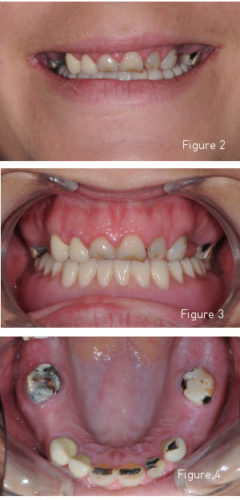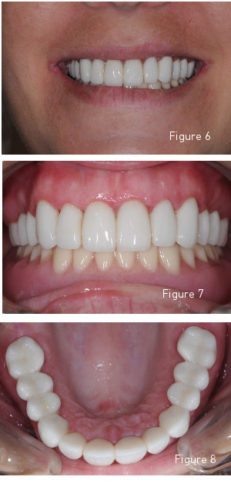
Dr. Thomas Dudney
What is the most common response when people are asked: “What is the first thing you notice when you meet someone?” It probably does not come as a big surprise that surveys show the answer most often given is a person’s smile. The smile is an important psychological component of their self-worth and an unattractive smile can negatively influence how people feel about themselves. As dentists and their teams are well aware, the ability to give someone a beautiful smile is one of the most rewarding things they can do both emotionally and financially.
someone?” It probably does not come as a big surprise that surveys show the answer most often given is a person’s smile. The smile is an important psychological component of their self-worth and an unattractive smile can negatively influence how people feel about themselves. As dentists and their teams are well aware, the ability to give someone a beautiful smile is one of the most rewarding things they can do both emotionally and financially.
In many cases the dental team is able to greatly improve a patient’s self-confidence and self-esteem and in dire situations can have a profound effect that may result in a life changing experience. To be able to achieve the desired results in smile design cases when utilizing indirect restorations, it is important that the dentist has the proper training and expertise as well as a good working relationship with the dental laboratory.
The smile design case presented in this article was challenging for a number of reasons. The patient was the winner of a contest called “Fix Momma’s Mouth” which our office has participated in for several years with a local radio show. The idea of the contest is for family members to submit a letter with pictures explaining why their mother should win a smile makeover for Mother’s day. The contest is designed to attract letters from listeners whose mother is embarrassed by the appearance of their smile and is unable to pay for the necessary treatment. Our office will then pick three finalists which are sent to the radio station where the pictures and letters are put on their website so listeners can vote to determine the winner who is then announced on the Monday after Mother’s Day.
With only the submitted pictures to go on when choosing the three finalists and with no x-rays or clinical exam beforehand, we can  sometimes encounter some surprises when we eventually see the contest winner, but must nevertheless treat whatever clinical condition exists. At the initial visit for this year’s winner we discovered after radiographs and a clinical exam that the patient/ contest winner had only 8 maxillary teeth (#’s 3, 6, 7, 8, 9, 10, 11 & 14 ), all with extensive decay, and a lower denture (Fig. 1-4). The patient said she had always had bad teeth and without the ability to pay for treatment, they had continued to get worse. She also said she was embarrassed by the appearance of her teeth and never smiled. Since it was not possible to do implants, two treatment plans were considered for restoring her smile: 1. build-ups and crowns on the maxillary teeth with a removable partial denture and 2. fixed bridges on teeth #’s 3-7 and 10-14 and crowns on teeth #’s 8 and 9. In an effort to avoid a removable appliance if possible, the latter treatment plan was chosen.
sometimes encounter some surprises when we eventually see the contest winner, but must nevertheless treat whatever clinical condition exists. At the initial visit for this year’s winner we discovered after radiographs and a clinical exam that the patient/ contest winner had only 8 maxillary teeth (#’s 3, 6, 7, 8, 9, 10, 11 & 14 ), all with extensive decay, and a lower denture (Fig. 1-4). The patient said she had always had bad teeth and without the ability to pay for treatment, they had continued to get worse. She also said she was embarrassed by the appearance of her teeth and never smiled. Since it was not possible to do implants, two treatment plans were considered for restoring her smile: 1. build-ups and crowns on the maxillary teeth with a removable partial denture and 2. fixed bridges on teeth #’s 3-7 and 10-14 and crowns on teeth #’s 8 and 9. In an effort to avoid a removable appliance if possible, the latter treatment plan was chosen.
At the next appointment, all of the decay was removed from the 8 maxillary teeth and they were built up to ideal size, shape, and occlusion with a flowable composite (Beautifil Flow Plus, Shofu). Additionally, indirect pulp caps (Theracal LC, Bisco) were placed in all the teeth with deep decay. Next, a sculptable composite was used to mock-up teeth to simulate pontics #’s 4, 5, 12 & 13 and then an impression was taken of the entire mock-up (#’s 3-14) and set aside to serve as a matrix for fabricating the provisionals. An occlusal bite was also taken and set aside, then the teeth were prepped, first the left side followed by relining the bite and then the right side again relining the bite in order to obtain an accurate occlusal record for mounting the models and to maintain the vertical dimension established by the mock-up. The following was forwarded to the laboratory; a full-arch maxillary impression, an impression of the opposing arch, the relined occlusal record, a face bow, stick bite, impression of the provisionals, pictures, and a written Rx detailing the goals of treatment, length of centrals, shade, and requesting layered zirconia bridges #’s 3-7 and 10-14 and layered zirconia crowns #’s 8 & 9. When the patient returned for the seat appointment the temporaries were removed and the definitive restorations were first tried in and then cemented with a bioceramic luting cement (Ceramir C & B, Doxa). Because of the excellent work of the laboratory, the fit was ideal and very little if any occlusal adjustment was necessary.
As stated at the beginning of this article, smile design cases can be very rewarding because of the positive emotional impact they have on our patient’s lives and the sense of accomplishment felt by the entire dental team. Furthermore, due to the number of teeth that often must be restored in order to achieve successful results, these cases can also be very financially rewarding. However, there is something extremely rewarding about providing this type of work for those less fortunate who might not be able to afford treatment and have to go through life embarrassed or ashamed to smile. Dentists and their teams across the country through many worthwhile programs or simply on their own have been able to experience a great sense of satisfaction by donating their time and expertise.
 This case would not have been possible without the efforts of Gary Vaughn and his entire team at Corr Dental Lab who donated their time and talents so that this patient might be able to feel confident and enjoy smiling again. A big thank you to Gary and his team for a job well done under less than ideal conditions. (Fig. 5-8)
This case would not have been possible without the efforts of Gary Vaughn and his entire team at Corr Dental Lab who donated their time and talents so that this patient might be able to feel confident and enjoy smiling again. A big thank you to Gary and his team for a job well done under less than ideal conditions. (Fig. 5-8)
If you have questions about my article or if you would like to send a case, please contact the Pacific Aesthetic Laboratory Group at www.pacificaestheticdentalstudio.com, Gary Vaughn, CDT, CTO (916) 786-6740, or via email gvaughn@thePAC.org.
